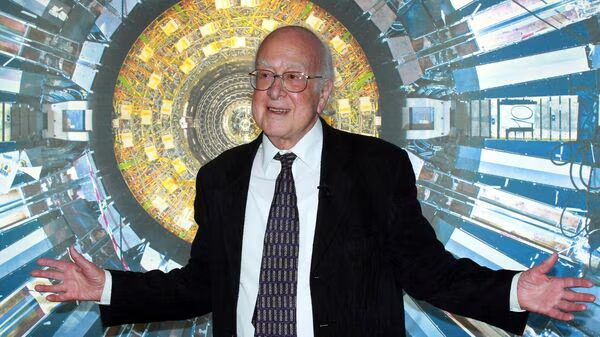At 94 years old, Nobel laureate Peter Higgs passed away. He devised a theoretical mechanism using the so-called Higgs boson particle, commonly referred to as the “God particle,” to explain the origin of mass in the universe.
Who is Peter Higgs
The British scientist Peter Higgs has away. He was awarded a Nobel Prize winner in 2013 for discovering a theoretical mechanism decades before others to explain the genesis of mass in the cosmos. He was ninety-four years old.
According to the University of Edinburgh, where he was an emeritus professor, he passed away on April 8 at home. The university’s vice chancellor and principal, Peter Mathieson, described Higgs as “a remarkable individual — a truly gifted scientist whose vision and imagination have enriched our knowledge of the world that surrounds us.”
Higgs and Belgian scientist Francois Englert split the Nobel Prize between them for their respective contributions to the understanding of mass-giving unseen fields in space and the presence of what is now known as the Higgs boson particle. Following the detection of the boson in the Large Hadron Collider, an underground laboratory near Geneva that smashes protons together at nearly the speed of light and captures data on their interaction, the European Nuclear Research Organization CERN announced the discovery of the elemental particle in 2012.
The discovery supported Higgs’ theories, which had been rejected as having “no obvious relevance to physics” in the journal Physics Letters nearly fifty years before their publication.
His efforts, together with independent predictions of a similar nature by Englert and his colleague Robert Brout, produced one of the century’s most important scientific discoveries. The boson field’s creative properties are referred to as the “God particle” in US physicist Leon Lederman’s book of the same name. This term may provide light on dark matter and dark energy, which make up around 96% of the universe but are still unknown to cosmologists.
The Standard Model of particle physics, which explains how matter stays together, was finalized with the discovery of the nearly instantaneous decay of the Higgs boson. Nothing could take shape if there was no mass because particles would just shoot out into space.
After Higgs’ Nobel Prize was announced, UK Prime Minister David Cameron commented, “This brilliant achievement is richly deserved recognition of Peter Higgs’ lifetime of dedicated research and his passion for science.”
Thousands of scientists working on the competing Atlas and CMS experiment teams at CERN confirmed the presence of the boson. To reproduce the conditions following the Big Bang approximately 13.7 billion years ago, particles were forced to collide in a circular supermagnetized tube measuring 27 kilometers (17 miles) in diameter. The project has a minimum $10 billion cost.
The Nobel Foundation claims that it is “probably the largest and the most complex machine ever constructed by humans.”
Also Read: 2025 Toyota 4Runner Arrives with Overland-Themed Trailhunter Trim!
Higgs Boson Theory
The Higgs boson is the fundamental particle associated with the Higgs field, a field that gives mass to other fundamental particles such as electrons and quarks.
Scientist Peter Higgs Modest Man
Higgs shed a tear when CERN’s scientists erupted in applause at a press conference revealing their discovery on July 4, 2012. The father of the Higgs boson was as modest in the limelight as his simple lifestyle suggested: He lived in a small flat in Edinburgh, had no television, and used public transport, according to the UK’s Telegraph newspaper.
“I regarded it as cheers for the home team, and the home team were the two experiments, Atlas and CMS,” he said in an interview with the BBC. “Maybe they were cheering me, too, but that was a minor issue.”
Higgs said the credit for predicting the mass-forming mechanism belonged to six physicists who contributed three papers on the subject in 1964: Englert and Brout, who wrote the first article, Higgs, and then Gerald Guralnik, Carl Hagen and Tom Kibble.
The Nobel Foundation, which allows three recipients of a prize and none posthumously, chose Higgs and Englert as winners.
Peter Ware Higgs was born in Newcastle-upon-Tyne in northeast England on May 29, 1929, to an English father and a Scottish mother. His father was a sound engineer for the BBC who lived apart from the family for much of Higgs’s childhood.
Higgs, who suffered from asthma and was partly schooled at home by his mother, lived in Birmingham and Bristol, where he attended Cotham Grammar School until 1946 and developed an interest in the work of physicist Paul Dirac. He graduated with first-class honors in physics from King’s College, University of London, in 1950, and completed a master’s and a doctorate on molecular vibrations.
Higgs held research fellowships in Edinburgh and London before becoming a lecturer in mathematical physics at the University of Edinburgh in 1960. He wrote his ground-breaking paper after developing the theory while walking in the hills around Edinburgh. Higgs was joined by the five other physicists who held similar views about the application of quantum field theory, considered outdated in physics at the time, in their quest to solve the problem of particle mass.
In 1980, Higgs became a professor of theoretical physics at the university, a post he held for 16 years.
Higgs, Brout, and Englert in 2004 won the Wolf Prize, administered by the Wolf Foundation in Israel, and the American Physical Society’s JJ Sakurai Prize for Theoretic Particle Physics in 2010, along with the five other scientists who contributed to work on the Higgs mechanism.
“It’s very nice to be right sometimes,” Higgs said after winning the Nobel Prize.
The Higgs boson was the subject of “Particle Fever,” a documentary that followed CERN scientists on the path to their groundbreaking discovery.
Higgs married an American linguist, Jody Williamson, whom he met at a university staff meeting in Edinburgh. The couple had two sons, Christopher and Jonathan, before their divorce in the early 1970s.
How was the Higgs boson discovery?
After a 40-year search, a subatomic particle with the expected properties was discovered in 2012 by the ATLAS and CMS experiments at the Large Hadron Collider (LHC) at CERN near Geneva, Switzerland. The new particle was subsequently confirmed to match the expected properties of a Higgs boson.
Why is the Higgs boson called the god particle?
The Higgs boson is popularly known as the “God Particle“. The name originated from Nobel Prize-winning physicist Leon Lederman’s book on the particle which he titled the “Goddamn Particle” — owing to frustration over how difficult it was to detect.

















Reader Interactions